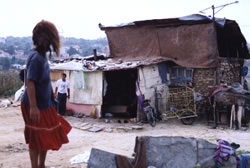|
Poverty Statistics:
* Almost 800 million people do not have enough food to eat.
* Each year, hunger kills 12 million children worldwide.
*There is enough food available to provide 4.3 pounds of food per person a day worldwide...enough to make most people fat!
* Every 3.6 seconds, a person dies from hunger and other preventable causes.
*1.3 billion people, about one fourth of the world population, lives in poverty.
*In Africa, funding universal education would require about billion more a year...about one and a half days worth of global military spending
*38% of the worlds grain if fed to livestock. Reducing American consumption of meat by 5% could save enough grain to feed 25 million people. Using grain to feed livestock is inefficient...6 servings of grain is equivalent to 1 serving of meat
*33 million Americans do not have enough food
*40% of households seeking the assistance of food banks had at least one family member employed
*6 million hungry Americans do not qualify for food stamps
*77% of the American families on food stamps include children
*Child poverty is more widespread in America than any industrialized country
*The U.S. does less than any industrialized country to pull its children out of poverty
*Most hunger deaths are caused not by starvation, but by chronic undernutrition, which can weaken the bodys immune system. When people do starve to death, the cause is almost always political
*23% of rural American children live in poverty
*It cost $1,500,000 to purchase 30 seconds of air time during the 1998 Super Bowl, which would feed 72,000 hungry children in the U.S. for one year
*Enough grains are produced to provide each human with 3,500 calories a day
*U.S. foreign aid: .8% of the budget goes toward foreign aid, and often works directly against the hungry. It is mostly used to impose free trade and free market policies, to promote exports at the expense of food production, and the provide armaments that repressive governments use to stay in power. It helps to widen the gap between the rich and poor. Even humanitarian aid, which makes up only 5% of the .8%, often ends up enriching American enterprises within the county and undercuts local food production in the country. It would be better to use foreign aid for unconditional debt relief so that countries can use their money to improve the plight of their people, rather than pay rich countries
*34,000 children die each day worldwide because of preventable disease & hunger
*3 billion people in the world live on less than two dollars a day
*Economic growth is a start, but not enough (Brazils 1972 fantastic growth of the economy only benefited 5% of its people, for example)
*2.25 billion people do not have access to flush toilets
*Iodine deficiency causes mental impairment in poor children. The cost of a program that would iodize the salt supply of every country would cost less than that of two modern fighter planes.
Inequality Stats/Scenarios:
High-Income group:
*15% of the world population and has yearly income of 9,400 dollars or more
*Consumes 70% of all the grain in the world
*Face health problems from being too fat
*Have good healthcare, good school systems, turn down credit offers frequently
*Own at least one car and two televisions
*Spend more money on entertainment in a year than most people in the world earn
*Average life expectancy is 77
Middle-Income group:
*30% of the world population and has yearly income between 765 dollars and 9,400 dollars
*Make less than many 1st world teens do at McDonalds
*It would take one drought or one illness to throw many in this group into poverty
*Most common work is day laborers; some have electricity but must ration it
*Boys have the opportunity to go to school a few years, girls often do not
*Even though this group works very hard, they cannot afford nutritious food
*There is little chance of middle-income people getting out of their category, unless a disaster causes them to move into the low-income group
*Children die five times faster than 1st world children
Low-Income group:
*55% of the worlds population and make less than 765 dollars a year
*Finding food, water, and shelter consumes most of these peoples entire day
*Its not uncommon for women to walk many miles each day to find water, spend several hours working in the fields, and take care of the children
*Many are homeless or live in structures that the wind or rain can destroy easily
*School and adequate healthcare is just a dream
*If people in this group have jobs, they are often tenant farmers who give their landowners 75% of the harvest each year
*Early death is common; many mothers lose 1-2 children before age 5
Scenario--Western Cow vs. Eastern Farmer:
*1.5 billion farmers in the developing world live in poverty while 1.5 billion cattle in the industrialized world live in luxury
*Cows receive subsidies almost twice as large as the annual income of an average Third World farmer
*Picture of a Third World farmer: owns two acres of land, lives under a thatched roof, owns no electric fan, no sanitation facilities and no government subsidies
*Picture of a U.S. cow: lives in a concrete barn with lights, fans, showers and central heating. Computer chips around the cows necks enable feeding machines to meet the exact nutritional requirement of each animal. Each cow requires 25 acres of land to meet its nutritional needs...enough to enable 10 farming families from the Third World to earn a living
|
 |